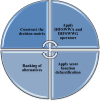An intelligent assessment of factors affecting new generations in the era of the internet and new media using intuitionistic hesitant fuzzy sugeno-weber aggregation operators
- PMID: 40603969
- PMCID: PMC12223228
- DOI: 10.1038/s41598-025-04683-0
An intelligent assessment of factors affecting new generations in the era of the internet and new media using intuitionistic hesitant fuzzy sugeno-weber aggregation operators
Abstract
The network of millions of linked devices that exchange resources is known as the Internet. The rapid expansion of digital connectivity necessitates an assessment and understanding of its multifaceted impact on younger generations. There are many benefits and drawbacks to using the Internet, including issues with human health, education and learning habits, communication and relationships, and privacy and security. Almost every area of life involves some degree of uncertainty and fuzziness. The best method for practically reducing ambiguity when determining the best option from fuzzy and uncertain data is multi-attribute decision-making (MADM). The research aims to develop a comprehensive decision framework for examining Internet effects on youth generations through fundamental behavioral and social elements. So, in this regard, the Intuitionistic Hesitant Fuzzy set (IHFS) is an effective and flexible tool for the investigation of uncertain information. The Sugeno-Weber operational (SWO) rules are a more generalized and flexible approach than other existing triangular norms (TN) and triangular conorm (TCN). Using SWOs and IHFS information, we construct the intuitionistic hesitant fuzzy Sugeno-Weber weighted averaging (IHFSWWA) and intuitionistic hesitant fuzzy Sugeno-Weber weighted geometric (IHFSWWG) operators. Also, we investigate some fundamental axioms of aggregation operators (AOs), like monotonicity, boundedness, and idempotency. We construct the MADM algorithm based on the developed theory, and some solve real-life numerical examples for assessment of factors affecting the new generations given the internet. To validate the effectiveness and practical applicability, a comparison analysis was conducted between the proposed IHFSWWA and IHFSWWG approaches with existing AOs. The conclusion is discussed in the last section.
Keywords: Aggregation operators; Internet and new media; Intuitionistic hesitant fuzzy set; Multi-attribute decision-making; Sugeno weber TN and TCN.
© 2025. The Author(s).
Conflict of interest statement
Competing interests: The authors declare no competing interests.
Figures
Similar articles
-
Scrutinizing the applicability of blockchain in the sustainability of supply chains using an intelligent fuzzy multi criteria decision making.Sci Rep. 2025 Jul 28;15(1):27442. doi: 10.1038/s41598-025-06776-2. Sci Rep. 2025. PMID: 40721718 Free PMC article.
-
A novel MCDM method for assessing student employability psychology using complex Pythagorean hesitant fuzzy Sugeno Weber aggregation.Sci Rep. 2025 Jul 22;15(1):26676. doi: 10.1038/s41598-025-10579-w. Sci Rep. 2025. PMID: 40695861 Free PMC article.
-
A Pythagorean fuzzy MCDM model for evaluating career happiness in sports by selecting a suitable sport.Sci Rep. 2025 Jul 1;15(1):22326. doi: 10.1038/s41598-025-05558-0. Sci Rep. 2025. PMID: 40594190 Free PMC article.
-
Cost-effectiveness of using prognostic information to select women with breast cancer for adjuvant systemic therapy.Health Technol Assess. 2006 Sep;10(34):iii-iv, ix-xi, 1-204. doi: 10.3310/hta10340. Health Technol Assess. 2006. PMID: 16959170
-
A rapid and systematic review of the clinical effectiveness and cost-effectiveness of paclitaxel, docetaxel, gemcitabine and vinorelbine in non-small-cell lung cancer.Health Technol Assess. 2001;5(32):1-195. doi: 10.3310/hta5320. Health Technol Assess. 2001. PMID: 12065068
References
-
- Zadeh, L. A. Fuzzy Sets. Inf. Control8, 338–353. 10.1016/S0019-9958(65)90241-X (1965).
-
- Atanassov, K. T. Intuitionistic Fuzzy Sets. Fuzzy Sets Syst.20, 87–96. 10.1016/S0165-0114(86)80034-3 (1986).
-
- Seikh, M. R. & Chatterjee, P. Evaluation and selection of e-learning websites using intuitionistic fuzzy confidence level based dombi aggregation operators with unknown weight information. Appl. Soft Comput.10.1016/j.asoc.2024.111850 (2024).
-
- Seikh, M. R. & Mandal, U. Q-rung orthopair fuzzy archimedean aggregation operators: Application in the site selection for software operating units. Symmetry15, 1680 (2023).
-
- Torra, V. Hesitant Fuzzy Sets. Int. J. Intell. Syst.25, 529–539. 10.1002/int.20418 (2010).
LinkOut - more resources
Full Text Sources







